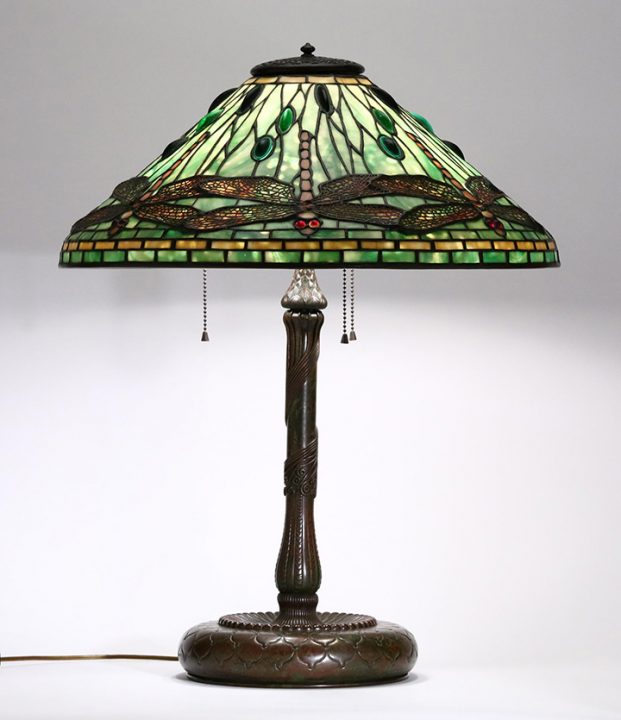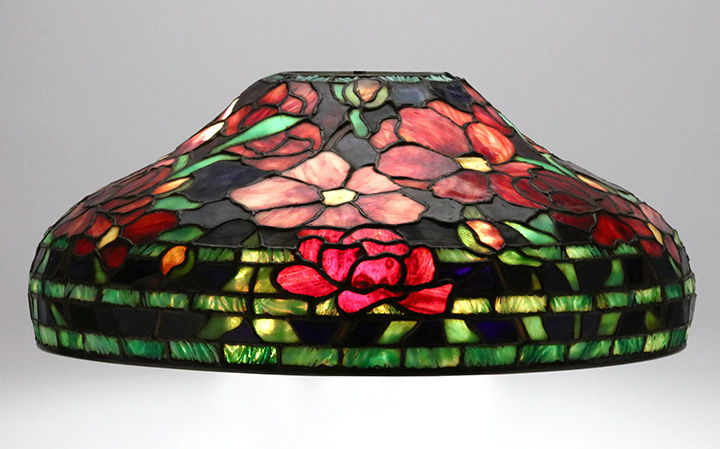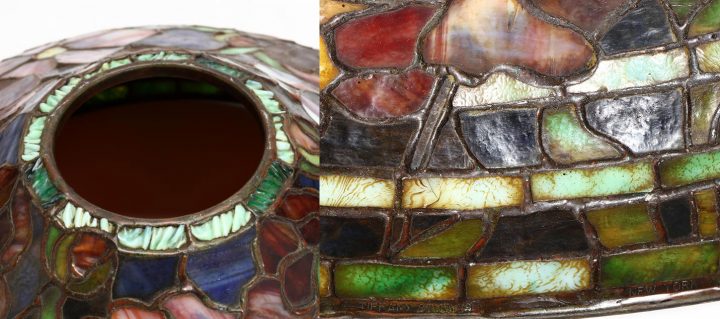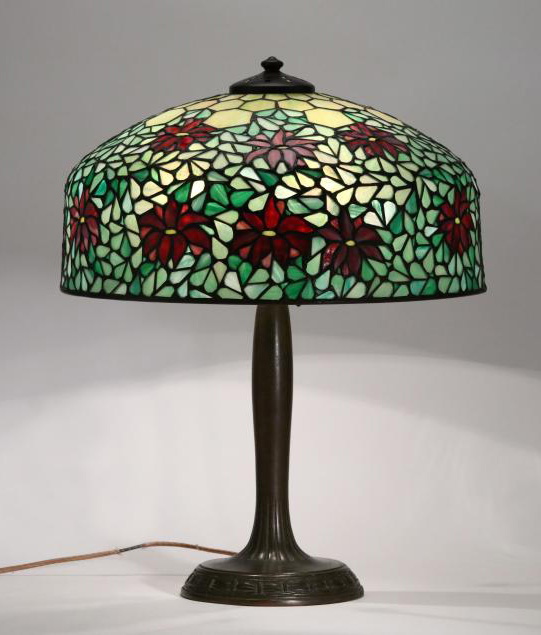I will do my best to publish a new post every Monday.
Leland Little Auctions, Hillsborough, NC, held a Signature Winter auction on December 4, 2021. Included in the sale were several lamps; the topic of this blog.

I tried to buy lot #207, a Tiffany Studios 20″ diameter Dragonfly table lamp. Unfortunately I was the underbidder. It realized $44,400, including buyer’s premium. It had some problems: Shade: 2.5 inch solder repair to fitter rim edge; the same area with four cracked glass panels; a few other scattered tight hairline cracks to glass panels; one of the upper green cabochons with chips; the lamp base with a dent to the underside edge of the base (only visible from underneath). Additionally the sockets were pull-chain and should have been turn-key. So the lamp needed about $3,000 to fully restore it.
I recently sold almost the identical lamp for a bit more and my lamp had no problems. So it made no sense to pay a total of approximately $47,500, then do a lot of work, then try to make a small profit.

The next lot, #208, is where the problems started. It was described on their website as follows:
Tiffany Studios “Peony” Stained Glass Shade Circa 1910, wavy textured and pulled glass panes in light green, yellow and rich reds, marked to interior base rim “Tiffany Studios / New York / 1475”.
7.75 x 18.25 in. diameter; fitter rim 4.25 in.
Amongst the firm’s most consistently popular lamp models, the Peony remained in continuous production from its debut around 1900 until the late 1920s.
Good as found condition; no cracks found; rich reddish brown patina to bronze solder; brown residue to interior and exterior of glass.
$20,000 – 40,000

The problem is that it wasn’t by Tiffany Studios, but rather a modern reproduction. Take a look at a closeup of the ripple glass. Note that the waves are random, whereas Tiffany ripple glass has much more orderly ripples. Also note that the shade is described as having brown residue to interior and exterior of glass. That trick was done by immersing the shade in tea and letting it dry. Then look at the signature tag, which was bogus.
I’m fairly sure that Leland Little Auction is a reputable auction house, but without Tiffany experts. Had they hired an outside expert (me, perhaps), the lot would have been listed as Tiffany-style, modern, with an estimate of $2,000 – $3,000. Knowledgeable people didn’t bid, as evidenced by the final price of $30,000, including buyer’s premium. If it were authentic, it would have sold for double or triple that. So that means a novice bought it and is going to be really unhappy when he/she finds out.

The next lot, #209, had a similar problem. It was sold as Handel, Stained Glass Table Lamp. But it wasn’t; well at least the shade wasn’t (the base was authentic.) In all probability, the shade was a modern reproduction. It’s possible that it was by Unique, a New York lamp maker of the period, but probably not. They used similarly-shaped flowers and background glass, but their shades always had zigzag irregular lower rims. Additionally, the cap on this example was for reverse-painted lamps only. Handel used special openwork caps for their leaded shades.
Again I think knowledgeable buyers did not bid. It sold for only $2,160, including buyer’s premium. It would have sold for well above that price if it had been authentic, as evidenced by some recent sales at other auction houses.
For the complete results of the sale, click here.Let me know what interests you, even if you don’t see it on my website. I’ve got lots of items that I haven’t listed yet and I know how to locate what you desire.
I listed some of the new items on my website and will list more every week. Click Philip Chasen Antiques to take a look. I will make every effort to actively list new items as often as time permits. I always strive to offer the finest objects for sale on my website and at every show. There are many items for sale, sold items with prices and free lessons about glass and lamps. And remember to keep reading my blog.

I have first hand knowledge of the dragonfly Tiffany lamp. I was the one who referred it for my clients. Leland Little was very thorough and had the lamp authenticated and the condition assessed before they put it in the auction. The fact that you did bid on it and did not get it almost sounds like sour grapes. People often pay over the value during an auction because it’s not a matter of reselling it but rather it’s a matter of having a piece of beautiful history and art to grace their homes and lives for generations to come. If you’re in the resell business, you might get lucky in an auction and win something undervalued however more often than not with a reputable auction house you will be out bid. I have referred to Leland Little for over a decade. I do not remember an occasion where my clients were disappointed.